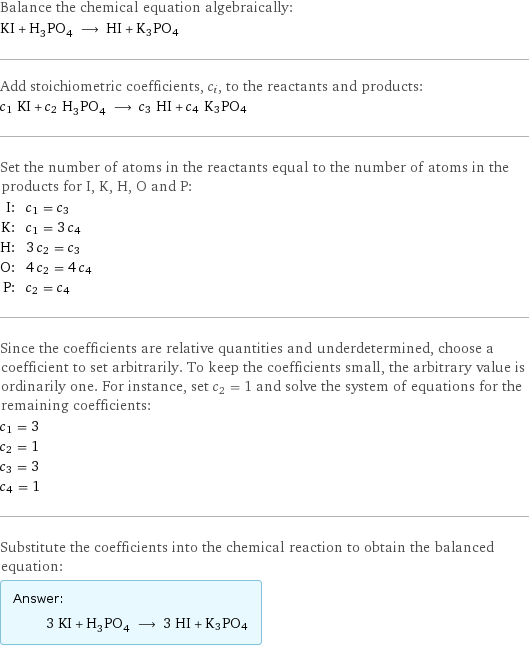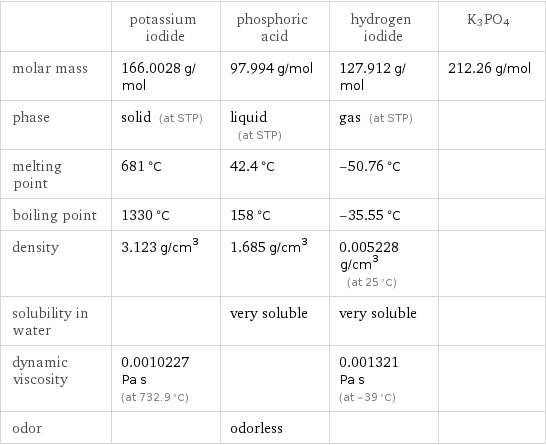Input interpretation

KI potassium iodide + H_3PO_4 phosphoric acid ⟶ HI hydrogen iodide + K3PO4
Balanced equation

Balance the chemical equation algebraically: KI + H_3PO_4 ⟶ HI + K3PO4 Add stoichiometric coefficients, c_i, to the reactants and products: c_1 KI + c_2 H_3PO_4 ⟶ c_3 HI + c_4 K3PO4 Set the number of atoms in the reactants equal to the number of atoms in the products for I, K, H, O and P: I: | c_1 = c_3 K: | c_1 = 3 c_4 H: | 3 c_2 = c_3 O: | 4 c_2 = 4 c_4 P: | c_2 = c_4 Since the coefficients are relative quantities and underdetermined, choose a coefficient to set arbitrarily. To keep the coefficients small, the arbitrary value is ordinarily one. For instance, set c_2 = 1 and solve the system of equations for the remaining coefficients: c_1 = 3 c_2 = 1 c_3 = 3 c_4 = 1 Substitute the coefficients into the chemical reaction to obtain the balanced equation: Answer: | | 3 KI + H_3PO_4 ⟶ 3 HI + K3PO4
Structures

+ ⟶ + K3PO4
Names

potassium iodide + phosphoric acid ⟶ hydrogen iodide + K3PO4
Equilibrium constant
![Construct the equilibrium constant, K, expression for: KI + H_3PO_4 ⟶ HI + K3PO4 Plan: • Balance the chemical equation. • Determine the stoichiometric numbers. • Assemble the activity expression for each chemical species. • Use the activity expressions to build the equilibrium constant expression. Write the balanced chemical equation: 3 KI + H_3PO_4 ⟶ 3 HI + K3PO4 Assign stoichiometric numbers, ν_i, using the stoichiometric coefficients, c_i, from the balanced chemical equation in the following manner: ν_i = -c_i for reactants and ν_i = c_i for products: chemical species | c_i | ν_i KI | 3 | -3 H_3PO_4 | 1 | -1 HI | 3 | 3 K3PO4 | 1 | 1 Assemble the activity expressions accounting for the state of matter and ν_i: chemical species | c_i | ν_i | activity expression KI | 3 | -3 | ([KI])^(-3) H_3PO_4 | 1 | -1 | ([H3PO4])^(-1) HI | 3 | 3 | ([HI])^3 K3PO4 | 1 | 1 | [K3PO4] The equilibrium constant symbol in the concentration basis is: K_c Mulitply the activity expressions to arrive at the K_c expression: Answer: | | K_c = ([KI])^(-3) ([H3PO4])^(-1) ([HI])^3 [K3PO4] = (([HI])^3 [K3PO4])/(([KI])^3 [H3PO4])](../image_source/79920085102045a3adfdd271578ff3ad.png)
Construct the equilibrium constant, K, expression for: KI + H_3PO_4 ⟶ HI + K3PO4 Plan: • Balance the chemical equation. • Determine the stoichiometric numbers. • Assemble the activity expression for each chemical species. • Use the activity expressions to build the equilibrium constant expression. Write the balanced chemical equation: 3 KI + H_3PO_4 ⟶ 3 HI + K3PO4 Assign stoichiometric numbers, ν_i, using the stoichiometric coefficients, c_i, from the balanced chemical equation in the following manner: ν_i = -c_i for reactants and ν_i = c_i for products: chemical species | c_i | ν_i KI | 3 | -3 H_3PO_4 | 1 | -1 HI | 3 | 3 K3PO4 | 1 | 1 Assemble the activity expressions accounting for the state of matter and ν_i: chemical species | c_i | ν_i | activity expression KI | 3 | -3 | ([KI])^(-3) H_3PO_4 | 1 | -1 | ([H3PO4])^(-1) HI | 3 | 3 | ([HI])^3 K3PO4 | 1 | 1 | [K3PO4] The equilibrium constant symbol in the concentration basis is: K_c Mulitply the activity expressions to arrive at the K_c expression: Answer: | | K_c = ([KI])^(-3) ([H3PO4])^(-1) ([HI])^3 [K3PO4] = (([HI])^3 [K3PO4])/(([KI])^3 [H3PO4])
Rate of reaction
![Construct the rate of reaction expression for: KI + H_3PO_4 ⟶ HI + K3PO4 Plan: • Balance the chemical equation. • Determine the stoichiometric numbers. • Assemble the rate term for each chemical species. • Write the rate of reaction expression. Write the balanced chemical equation: 3 KI + H_3PO_4 ⟶ 3 HI + K3PO4 Assign stoichiometric numbers, ν_i, using the stoichiometric coefficients, c_i, from the balanced chemical equation in the following manner: ν_i = -c_i for reactants and ν_i = c_i for products: chemical species | c_i | ν_i KI | 3 | -3 H_3PO_4 | 1 | -1 HI | 3 | 3 K3PO4 | 1 | 1 The rate term for each chemical species, B_i, is 1/ν_i(Δ[B_i])/(Δt) where [B_i] is the amount concentration and t is time: chemical species | c_i | ν_i | rate term KI | 3 | -3 | -1/3 (Δ[KI])/(Δt) H_3PO_4 | 1 | -1 | -(Δ[H3PO4])/(Δt) HI | 3 | 3 | 1/3 (Δ[HI])/(Δt) K3PO4 | 1 | 1 | (Δ[K3PO4])/(Δt) (for infinitesimal rate of change, replace Δ with d) Set the rate terms equal to each other to arrive at the rate expression: Answer: | | rate = -1/3 (Δ[KI])/(Δt) = -(Δ[H3PO4])/(Δt) = 1/3 (Δ[HI])/(Δt) = (Δ[K3PO4])/(Δt) (assuming constant volume and no accumulation of intermediates or side products)](../image_source/8f1cebfe2248c7cd21354888b86b79ca.png)
Construct the rate of reaction expression for: KI + H_3PO_4 ⟶ HI + K3PO4 Plan: • Balance the chemical equation. • Determine the stoichiometric numbers. • Assemble the rate term for each chemical species. • Write the rate of reaction expression. Write the balanced chemical equation: 3 KI + H_3PO_4 ⟶ 3 HI + K3PO4 Assign stoichiometric numbers, ν_i, using the stoichiometric coefficients, c_i, from the balanced chemical equation in the following manner: ν_i = -c_i for reactants and ν_i = c_i for products: chemical species | c_i | ν_i KI | 3 | -3 H_3PO_4 | 1 | -1 HI | 3 | 3 K3PO4 | 1 | 1 The rate term for each chemical species, B_i, is 1/ν_i(Δ[B_i])/(Δt) where [B_i] is the amount concentration and t is time: chemical species | c_i | ν_i | rate term KI | 3 | -3 | -1/3 (Δ[KI])/(Δt) H_3PO_4 | 1 | -1 | -(Δ[H3PO4])/(Δt) HI | 3 | 3 | 1/3 (Δ[HI])/(Δt) K3PO4 | 1 | 1 | (Δ[K3PO4])/(Δt) (for infinitesimal rate of change, replace Δ with d) Set the rate terms equal to each other to arrive at the rate expression: Answer: | | rate = -1/3 (Δ[KI])/(Δt) = -(Δ[H3PO4])/(Δt) = 1/3 (Δ[HI])/(Δt) = (Δ[K3PO4])/(Δt) (assuming constant volume and no accumulation of intermediates or side products)
Chemical names and formulas

| potassium iodide | phosphoric acid | hydrogen iodide | K3PO4 formula | KI | H_3PO_4 | HI | K3PO4 Hill formula | IK | H_3O_4P | HI | K3O4P name | potassium iodide | phosphoric acid | hydrogen iodide |
Substance properties

| potassium iodide | phosphoric acid | hydrogen iodide | K3PO4 molar mass | 166.0028 g/mol | 97.994 g/mol | 127.912 g/mol | 212.26 g/mol phase | solid (at STP) | liquid (at STP) | gas (at STP) | melting point | 681 °C | 42.4 °C | -50.76 °C | boiling point | 1330 °C | 158 °C | -35.55 °C | density | 3.123 g/cm^3 | 1.685 g/cm^3 | 0.005228 g/cm^3 (at 25 °C) | solubility in water | | very soluble | very soluble | dynamic viscosity | 0.0010227 Pa s (at 732.9 °C) | | 0.001321 Pa s (at -39 °C) | odor | | odorless | |
Units
